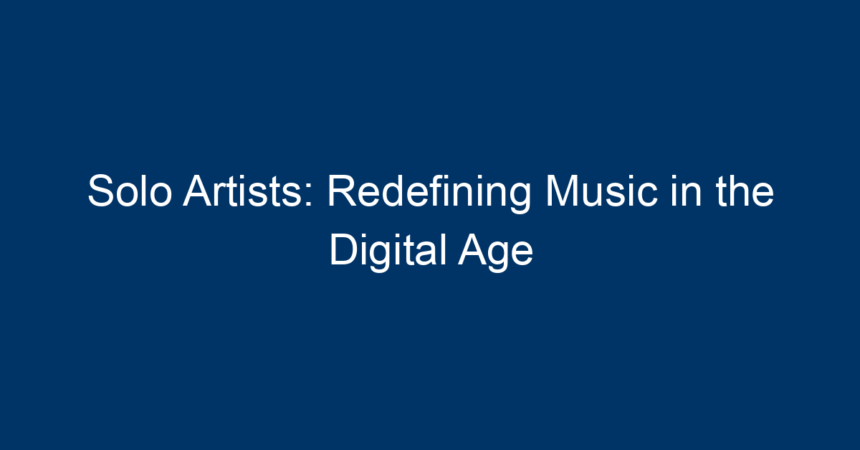As the music industry evolves, so too do the artists who inhabit it. Among these innovators, solo artists have redefined what it means to create, distribute, and experience music in the digital age. In this article, we will explore the impact of solo artists on the music landscape, delve into the challenges they face, and discuss how technology is empowering them to connect with audiences in unprecedented ways. With the rise of streaming platforms, social media, and DIY production, solo artists are more influential than ever before.
The Rise of Solo Artists
Historical Context
Historically, the music industry was dominated by major record labels which sought to control every aspect of an artist’s career—from production to marketing. This system often marginalized solo artists, relegating them to the fringes. However, the digital age has flipped this model on its head, allowing individuals to take creative control and reach global audiences without the need for traditional gatekeepers.
A New Era for Music Makers
Today, solo artists can record high-quality music in their own homes using affordable technology. With tools like digital audio workstations (DAWs) and mobile recording apps, artists can create music that rivals what major studios produce. This democratization of music production has leveled the playing field, encouraging more people to pursue their passion for music.
The Impact of Streaming Platforms
Accessibility and Exposure
One of the game-changers in the music industry has been the advent of streaming platforms, such as Spotify, Apple Music, and SoundCloud. These platforms have made music accessible to millions of users worldwide, giving solo artists unique opportunities for exposure.
By allowing artists to upload their work directly, these platforms eliminate the need for a record label, which historically controlled distribution. Independent solo artists can now reach a global audience with just a few clicks, promoting their music on social media and connecting directly with fans.
The Algorithm Advantage
The algorithms used by streaming services play a crucial role in promoting music. Solo artists can benefit from being featured in playlists tailored to specific genres, moods, or activities. This exposure can catapult new and emerging artists into the spotlight, something that was previously difficult without substantial marketing budgets.
Social Media: The New Stage
Building a Personal Brand
In the digital age, social media has transformed how solo artists engage with their fans. Platforms like Instagram, TikTok, and Twitter allow artists to share their creative process, promote their music, and connect with audiences on a personal level.
Building a strong personal brand is essential for solo artists. Creating engaging content—from behind-the-scenes footage to live performances—can help establish a loyal fan base. By humanizing themselves and being authentic, solo artists can cultivate a community of supporters who actively promote their work.
Viral Hits and Challenges
Social media also amplifies the potential for music to go viral. A catchy tune or unique performance can result in rapid shares, leading to an explosion of listens across streaming platforms. This phenomenon was notably exemplified by artists like Lil Nas X, whose song "Old Town Road" gained popularity through TikTok before topping charts worldwide.
However, the rapid pace of trends also means that solo artists must be adaptable. Capitalizing on current events or trends can be an effective way to garner attention, but it also requires artists to stay alert and responsive.
The Role of DIY Production
Maintaining Creative Control
With advancements in technology, the ability to produce high-quality music independently has never been more accessible. Solo artists can now record, mix, and master their tracks from their bedrooms, resulting in a significant reduction in overhead costs. This DIY approach not only allows for greater creative freedom but also enables artists to maintain control over their artistic vision.
Quality Meets Accessibility
While DIY production tools have made creating music accessible to anyone with a passion, maintaining quality is crucial. Artists who invest time in learning production techniques can create polished tracks that can compete with those from major studios. Online courses and tutorials provide ample resources for solo artists looking to sharpen their skills.
Monetization in the Digital Age
Diverse Income Streams
In the digital age, the question of monetization is critical for solo artists. Traditional revenue sources, like album sales, have dwindled, pushing artists to explore new income streams. Fortunately, the digital landscape offers multiple avenues for monetization:
-
Streaming Revenue: Though often small per-stream payments, they add up with a dedicated listener base.
-
Merchandising: Selling branded merchandise directly to fans strengthens community ties and generates additional income.
-
Crowdfunding: Platforms like Patreon and Kickstarter allow fans to support artists directly, often in exchange for exclusive content and experiences.
- Live Performances: Despite the challenges posed by the pandemic, livestreaming concerts and performances have become increasingly popular. Solo artists can reach fans worldwide without the costs associated with touring.
The Importance of Fan Engagement
Building a dedicated fan base is essential for monetization. Engaging directly with fans through social media, newsletters, and live events fosters a sense of community and loyalty. Solo artists who make an effort to connect with their audience often find stronger financial support and greater opportunities for collaboration.
Challenges Faced by Solo Artists
The Pressure of Multi-Tasking
While being a solo artist offers independence, it also comes with challenges. Many artists find themselves juggling multiple roles—creator, marketer, manager, and publicist—all at once. This pressure can lead to burnout and frustration, particularly when balancing artistic pursuits with business logistics.
Cutthroat Competition
With a growing number of solo artists emerging daily, competition in the digital music space is fierce. Standing out among a sea of talented musicians requires not only high-quality music but also savvy marketing and promotion strategies.
Conclusion: The Future of Solo Artists
The digital age has ushered in a new era for solo artists, redefining how music is created, shared, and consumed. While challenges lie ahead, opportunities continue to expand, offering artists unprecedented avenues for success.
Actionable Insights for Aspiring Solo Artists
-
Invest in Skills: Take advantage of online tutorials and courses to hone your production, marketing, and performance skills.
-
Engage Your Audience: Utilize social media to connect with fans on a personal level, sharing your journey and creativity.
-
Explore Diverse Income Streams: Don’t rely solely on streaming revenue; consider merchandising, crowdfunding, and live performances as vital parts of your income strategy.
-
Stay Adaptable: The digital landscape is always changing. Be willing to pivot your strategy and try new approaches to reach your audience.
- Collaborate: Seek opportunities to collaborate with other artists to expand your reach and expose your music to new audiences.
As we move further into the digital age, solo artists are poised to continue shaping the music industry. By embracing technology, connecting with fans, and maintaining their creative integrity, these artists are redefining what it means to make music today.




